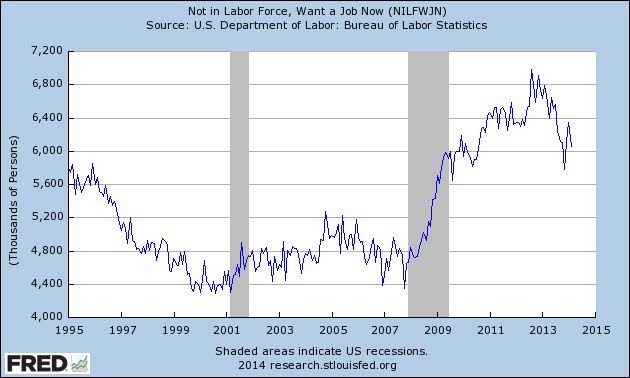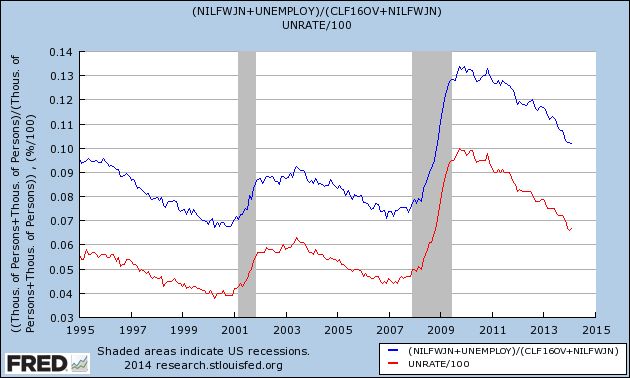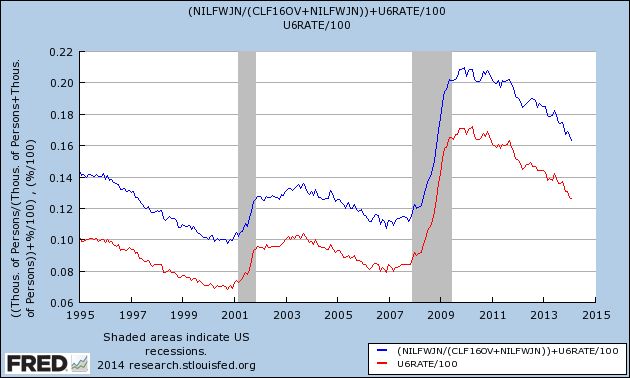- by New Deal democrat
In order to be counted among the unemployed for purposes of the monthly jobs survey, a person must have actively looked for a job during the reference period. Several sources, including Mish and the Economic Policy Institute, have attempted to measure the number of "missing workers", which EPI in their press release describes as:
potential workers who, because of weak job opportunities, are neither employed nor actively seeking a job. In other words, these are people who would be either working or looking for work if job opportunities were significantly stronger.The monthly household jobs survey measures exactly this in a statistic called "not in labor force, want a job now." Despite this, the EPI's "missing workers" metric uses the household report's measure of the unemployed, and measure of the civilian labor force, but then ignores the "not in labor force, want a job now" statistic in the exact same survey, in favor of an extrapolation from the forecast of a 2006 Fed study. There has been no explanation from EPI as to why they have overlooked this actual, monthly-updated obvious metric in favor of an 8 year old study. Mish has published a rate that assumes the 2007 participation rate would have continued, i.e., that there is no such thing as the Baby Boom, whose oldest member was 61 in 2007, but nearly 1/3 of whom have now hit at least the early retirement age of 62. (To be fair, this month he dropped that and focused only on younger workers).
There really is no reason to look further than the monthly report, which measures precisely this number in a series called "not in labor force, want a job now." Here's what that metric shows for the last 20 years:

The number of discouraged workers rose by nearly 2,000,000 in the wake of the great recession, but has declined by about 1/3 of that number in the last year or so.
In order to find out what the "real" unemployment rate is, including such discouraged workers, we simply add the number of people shown above to both the numerator (unemployed) and denominator (civilian labor force, which excludes those adults not interested in jobs, like retirees) of the statistics used for the unemployment rate. Here's what that shows:

The usually reported unemployment rate (U3, in red) is currently 6.7%. The "real" unemployment rate including those who want a job but haven't looked (blue) is 10.1%.
While this is by no means good, it is important to compare apples to apples. Note that the current rate is only slightly above that of 1995, and even at the height of the late 1990's tech boom, the best economy the US has seen since the 1960's, this rate was 6.7%.
We can perform a similar calculation to get the "real underemployment rate," i.e., which adds those who are working part time for economic reasons or are otherwise marginally attached to the workforce:

The "real" underemployment rate is 16.1% (blue) vs. 12.6% (red). Again, note that even in the 1990's tech boom, this rate never got below 9.9%.
Ironically, because I have been critical of both the EPI's and Mish's methods, the above "real" rates for February 2014 are similar to their conclusions. It appears that both EPI and Mish seriously undercounted the number of "missing workers" earlier in the post-recession period. The calculation above is in accord with recent papers by the Atlanta Fed , researchers at the IMF, and Shigeru Fujita of the Philadelphia Fed that, while most of the increase in the "missing workers" initially was due to discouragement, in the several years there has been a relative increase in the number of retiring Boomers, thus reducing the number of those who are "not in the labor force, [but] want a job now."
It is also in accord with a recent study by the St. Louis Fed showing that that the older age cohorts have seen a much bigger bounce in their net worth, on average, than younger age cohorts, due to the increase in house prices in the last two years. This means that more older workers have hit their finacnial "target" and felt able to retire.